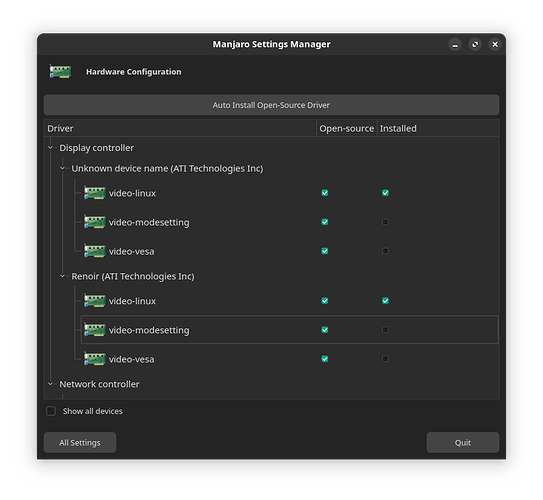Hi,
I have installed a graphics card (AMD RX 6400 4GB) into my PC that has integrated graphics (Ryzen 3 4350GE ) - this is my first time iinstalling a graphics card.
I am not sure if my system is using the right driver to take advantage of the new card.
I’m expecting that the new card will now take over from the built-in graphics.
I’m going to use the PC for Steam in the living room.
In Steam “Sys Info” Vram says 512MB & not 4GB. So this got me wondering if i am using the right driver or if the new card is properly enabled.
TV HDMI cable is connected to the RX6400 & the display is working fine. I will only use 1 display, so the motherboard HDMI output wont be used from now on, unless the card breaks or something.
Software is up-to-date. This is a fresh install of Manjaro Gnome from latest ISO.
Steam app, system info:
Video Card:
Driver: AMD AMD Radeon Graphics (renoir, LLVM 16.0.6, DRM 3.54, 6.6.8-2-MANJARO)
Driver Version: 4.6 (Compatibility Profile) Mesa 23.1.9-manjaro1.1
OpenGL Version: 4.6
Desktop Color Depth: 24 bits per pixel
Monitor Refresh Rate: 59 Hz
VendorID: 0x1002
DeviceID: 0x1636
Revision Not Detected
Number of Monitors: 1
Number of Logical Video Cards: 2
Primary Display Resolution: 1920 x 1080
Desktop Resolution: 1920 x 1080
Primary Display Size: 35.04" x 19.69" (40.16" diag), 89.0cm x 50.0cm (102.0cm diag)
Primary VRAM: 512 MB
I took the following steps to investigate why steam says 512MB instead of the expected 4GB, but im not sure what to conclude because its my first time using a graphics card; maybe it’s normal? maybe i need to disable the built in driver?
glxinfo | grep OpenGL
OpenGL vendor string: AMD
OpenGL renderer string: AMD Radeon Graphics (renoir, LLVM 16.0.6, DRM 3.54, 6.6.8-2-MANJARO)
OpenGL core profile version string: 4.6 (Core Profile) Mesa 23.1.9-manjaro1.1
OpenGL core profile shading language version string: 4.60
OpenGL core profile context flags: (none)
OpenGL core profile profile mask: core profile
OpenGL core profile extensions:
OpenGL version string: 4.6 (Compatibility Profile) Mesa 23.1.9-manjaro1.1
OpenGL shading language version string: 4.60
OpenGL context flags: (none)
OpenGL profile mask: compatibility profile
OpenGL extensions:
OpenGL ES profile version string: OpenGL ES 3.2 Mesa 23.1.9-manjaro1.1
OpenGL ES profile shading language version string: OpenGL ES GLSL ES 3.20
OpenGL ES profile extensions:
sudo lshw -C display
*-display
description: VGA compatible controller
product: Navi 24 [Radeon RX 6400/6500 XT/6500M]
vendor: Advanced Micro Devices, Inc. [AMD/ATI]
physical id: 0
bus info: pci@0000:03:00.0
logical name: /dev/fb0
version: c7
width: 64 bits
clock: 33MHz
capabilities: pm pciexpress msi vga_controller bus_master cap_list rom fb
configuration: depth=32 driver=amdgpu latency=0 mode=3840x2160 resolution=3840,2160 visual=truecolor xres=3840 yres=2160
resources: iomemory:1010-100f iomemory:1000-fff irq:41 memory:10100000000-101ffffffff memory:10080000000-100801fffff ioport:3000(size=256) memory:fc700000-fc7fffff memory:fc820000-fc83ffff
*-display
description: VGA compatible controller
product: Renoir [Radeon RX Vega 6 (Ryzen 4000/5000 Mobile Series)]
vendor: Advanced Micro Devices, Inc. [AMD/ATI]
physical id: 0
bus info: pci@0000:08:00.0
version: da
width: 64 bits
clock: 33MHz
capabilities: pm pciexpress msi msix vga_controller bus_master cap_list
configuration: driver=amdgpu latency=0
resources: iomemory:1000-fff iomemory:1000-fff irq:24 memory:10030000000-1003fffffff memory:10040000000-100401fffff ioport:1000(size=256) memory:fc300000-fc37ffff
lspci | grep -i VGA
03:00.0 VGA compatible controller: Advanced Micro Devices, Inc. [AMD/ATI] Navi 24 [Radeon RX 6400/6500 XT/6500M] (rev c7)
08:00.0 VGA compatible controller: Advanced Micro Devices, Inc. [AMD/ATI] Renoir [Radeon RX Vega 6 (Ryzen 4000/5000 Mobile Series)] (rev da)
lspci -v -s 03:00.0
03:00.0 VGA compatible controller: Advanced Micro Devices, Inc. [AMD/ATI] Navi 24 [Radeon RX 6400/6500 XT/6500M] (rev c7) (prog-if 00 [VGA controller])
Subsystem: Sapphire Technology Limited Navi 24 [Radeon RX 6400/6500 XT/6500M]
Flags: bus master, fast devsel, latency 0, IRQ 41, IOMMU group 0
Memory at 10100000000 (64-bit, prefetchable) [size=4G]
Memory at 10080000000 (64-bit, prefetchable) [size=2M]
I/O ports at 3000 [size=256]
Memory at fc700000 (32-bit, non-prefetchable) [size=1M]
Expansion ROM at fc820000 [disabled] [size=128K]
Capabilities: <access denied>
Kernel driver in use: amdgpu
Kernel modules: amdgpu
